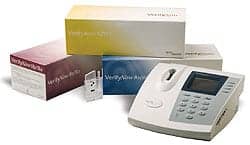 |
With more than 5,000 employees and 950 beds, Charleston Area Medical Center (CAMC) is the largest medical center in West Virginia. The entire CAMC Health System includes a research institute, a fundraising organization, and the newly acquired Teays Valley Hospital (formerly Putnam General). The lab in Teays Valley not only runs the tests for that branch, but supports the physicians’ offices in the outlying area and other partner hospitals, running as a pseudo-regional lab covering West Virginia and neighboring areas of Ohio and Kentucky.
When CAMC took the reins of Putnam General, it changed the name, as well as the way the whole operation worked. In November 2006, the staff had 2 months to get everything online and functioning cooperatively with the other hospitals in the network. The lab had to install, from scratch, computers, hardware, an LIS, and a billing system, and set it up to align with the rest of CAMC’s labs. Samuel Buckner, the laboratory director, said they made it “with a tremendous amount of help from SCC support on the phone. They were talking us through as we were building and setting up.”
Buckner, who was the LIS administrator for CAMC for nearly 10 years before he took over as director recently, has worked with SCC Soft Computer since 1998.
“I knew a lot of the support people, since we’ve worked together for so long,” he says. “They have a lot of faith in me, I have a lot of faith in them, and it’s a great partnership at this point.”
Strong Working Relationship
The partnership began when the LIS that CAMC was using was put out to pasture and the hospital started fresh, transferring all the patient demographics and information to microfiche and installing SoftLab as if the facility were a brand- new hospital.
“The old LIS, which I used as a lab technician, was OK. It got the main points, which I think most computer systems did back then, but it didn’t have any type of bells and whistles,” Buckner says. In fact, Buckner says it didn’t do anything other than results and reporting, so there was a lot of manual paper- work involved with the process. The decision to bring in SCC’s SoftLab was based on the robustness and versatility of the program, and because it had a lot of design for electronic documentation.
Moving up the career ladder from information systems lab technician to director, Buckner has seen the organization from every angle. The labs, he says, have done “a tremendous job of going from manual to automation.” CAMC has widely implemented autoverification, electronic documentation, and electronic QC, which allows the SCC LIS to stretch its legs and show the team what it can do.
SoftLab has allowed CAMC to forgo the use of any middlewear in its operations. “The LIS system we bought from SCC provides everything that middlewear provides,” he says. The user still has the ability to put multiple instruments on the screen, and it will flag automated results. Buckner says that being a former LIS administrator helps because he has advanced knowledge of what the software can do and how to make it work for the lab.
Buckner values the people at SCC. “What separates SCC from any other vendor I deal with is their dedication to the customer,” he says. “A lot of other vendors make it hard to get anything accomplished. SCC doesn’t—they are quick to respond.” He says SCC employees take it upon themselves to represent the company and to be accountable to the customer.
Looking Forward
As the new lab director, Buckner is relying on his background working with the LIS to help him run the newly acquired division. With strong knowledge of how workflow is supposed to progress, he is able to tell the staff how to process information through the system correctly. “As the LIS administrator you touch every workflow process,” he says. “Soft computer system does a tremendous job of flowing daily laboratory processes and incorporating them into our facility. The basis of the software is that it matches what the users do, the order they do it in, and how they conduct their business.”
CAMC is happy with SoftLab, and therefore will employ its SoftWeb, a Web-based LIS to be used by physicians’ offices and other outpatient facilities to order tests simply by printing out consent forms, signing, and sending specimens on their way. The new setup should eliminate many outpatient errors that result from miscommunications due to illegible handwriting and varying language.
At a multidivisional hospital, the biggest problem in running five labs is standardization and communication. SoftLab allows the user to program a set of parameters, not only for how the tests will be run, but also for how the results will display, right down to the formatting and capitalization. The reliably constant report can be read by any of the physicians in the network, no matter which lab ran the tests.
While serving more than 2,000 active physicians, familiarity goes a long way to ensuring proper communication.
Zac Dillon is associate editor of CLP.




